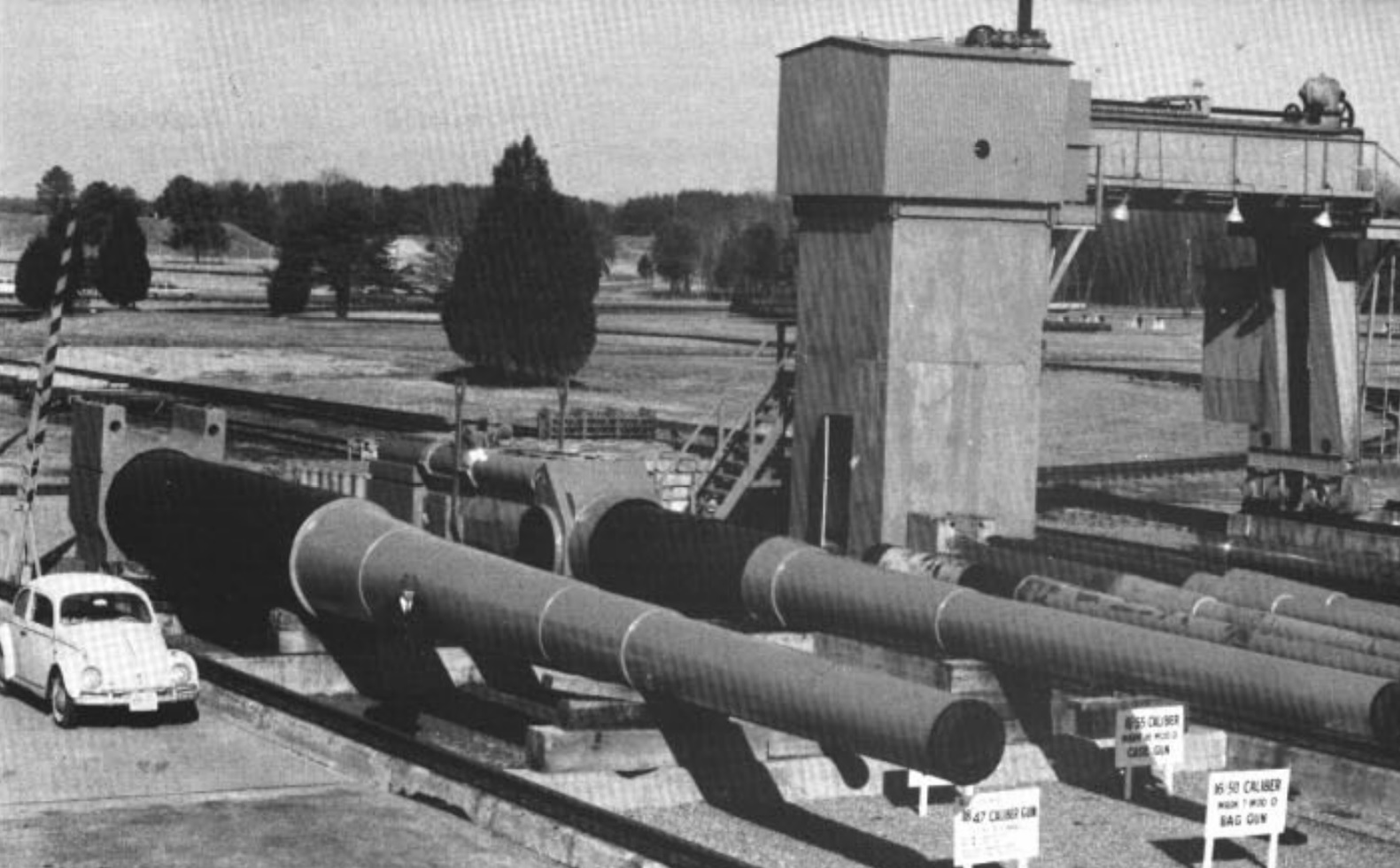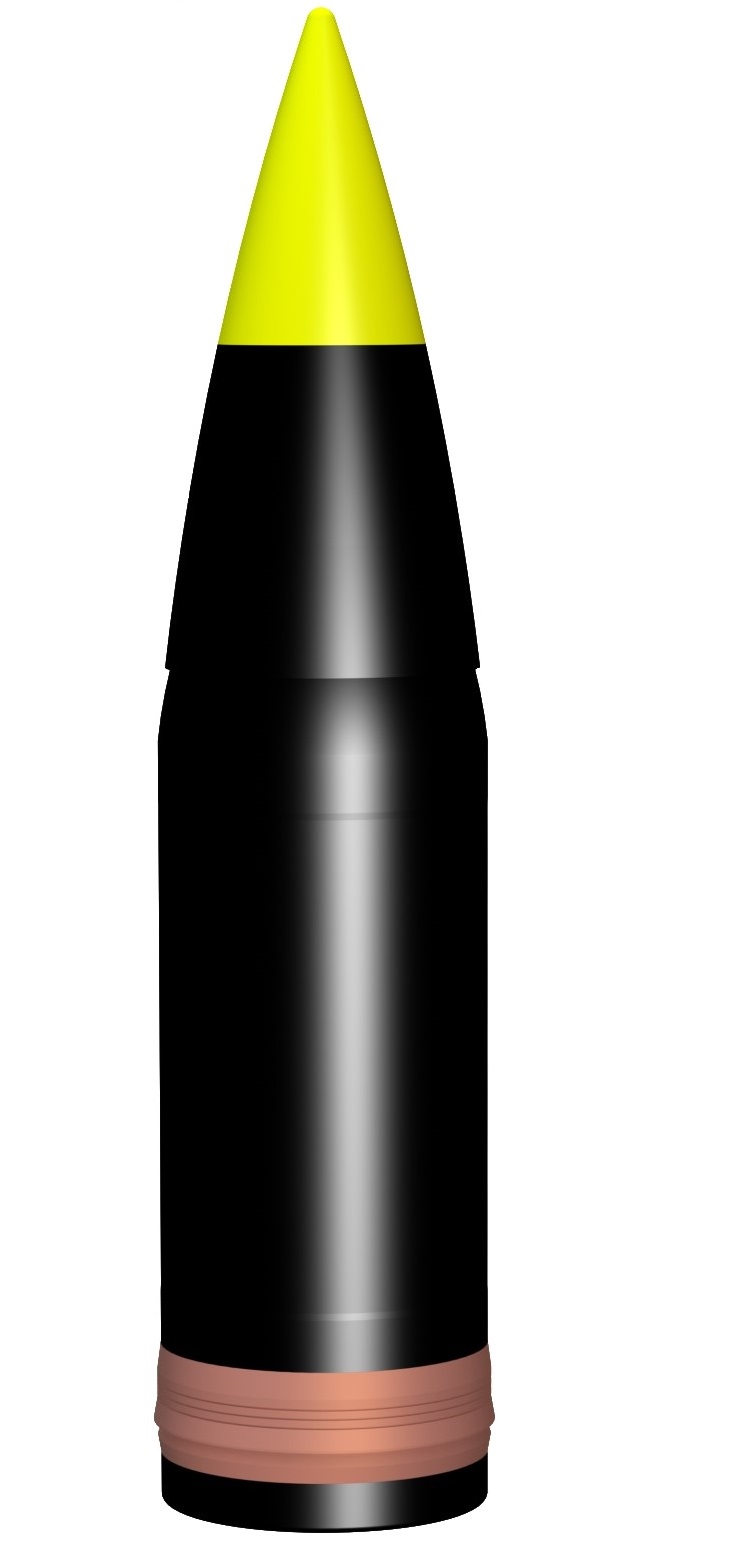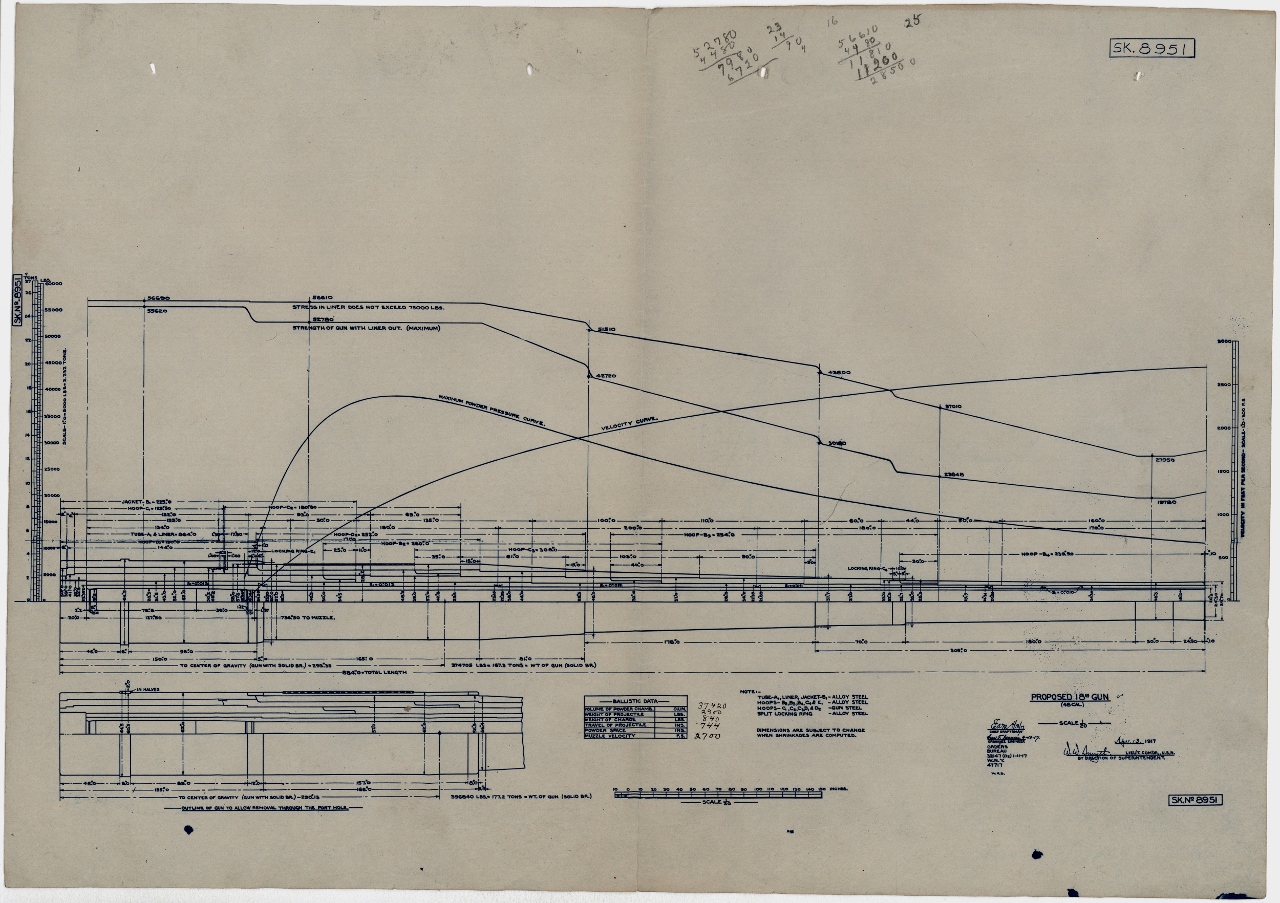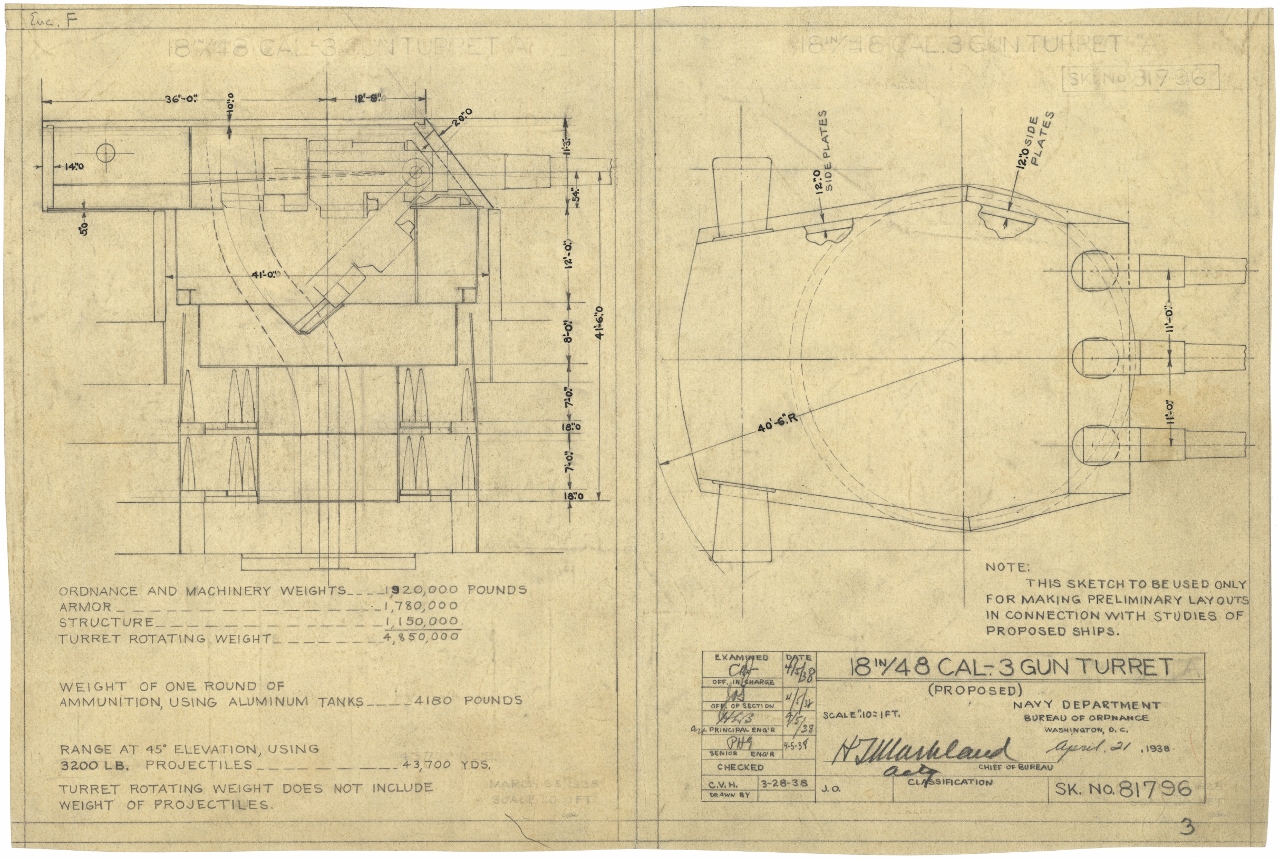
These three designations were all assigned to a single gun used for experimental testing purposes between 1927 and 1945. In the early 1920s, the USN was in the process of developing the 18"/48 (45.7 cm) Mark 1 naval gun. Two gun designs were considered, one was a light version and the other was a heavier version to allow removing the gun from a turret without dismantling it. The heavier version was chosen for development.
This prototype weapon was about halfway completed when the Washington Naval Limitation Treaty of 1922 banned guns larger than 16" (40.6 cm). As a result of the treaty, the USN decided to complete the prototype as an extra-long 16" (40.6 cm) weapon. This conversion was performed by grinding down the muzzle end, re-threading the barrel to hold an extension ring and inserting a thicker, 16" (40.6 cm) diameter liner. The prototype was then designated as the 16"/56 (40.6 cm) Mark 4 high-velocity test gun. Proofing began at the Dahlgren proving ground in July 1927 and the gun was fired throughout the 1930s in various tests.
Battleship design studies conducted in 1927-28 and again in 1938 considered using the 18"/48 (45.7 cm) gun, but the USN rejected it both times for the following reasons: 1) Excessive weight, 2) Very short liner life, 3) Lack of sufficient angle of descent for all but very long ranges - i.e., little deck penetration capability. The use of this weapon would also have violated all of the Naval Limitation Treaties of the 1920s and 1930s, possibly the most important factor in its rejection.
Tests with this weapon in the 1920s and 1930s convinced BuOrd that standard 18" (45.7 cm) AP projectiles had only marginally better armor penetration than 16" (40.6 cm) shells. In addition, design studies for what became the Iowa class (BB-61) battleships showed that this size battleship could carry a maximum of only six or seven of the much heavier 18" (45.7 cm) guns vs. nine 16"/50 (40.6 cm) guns, assuming that the armor protection and speed remained the same. The larger gun would also have had a slower rate of fire, as the heavier shells required would have been more difficult to handle. These conclusions led to the development of "Super-Heavy" AP projectiles in the late 1930s, which made the US guns using them superior to other nation's weapons of the same caliber.
The start of World War II removed all treaty limitations and revived interest in larger caliber weapons. In 1941, the threaded tip was cut off and a new 18" (45.7 cm) liner installed. This weapon was then redesignated as the 18"/47 (45.7 cm) Mark "A" test gun and "Super-Heavy" 18" (45.7 cm) AP projectiles were designed for it. The gun was first test fired in this new configuration in February 1942 and a few more times until the end of the war. The eclipse of the battleship by carrier aircraft greatly reduced the Navy's interest in pursuing further development of large caliber weapons and the last 18" (45.7 cm) projectile firing took place on 24 August 1945. The weapon was then used to test aircraft bombs before being fully retired in 1957. It is now on display at the Dahlgren Naval Weapons Facility in Virginia, USA, as shown in the adjacent photograph. For an expanded history of this weapon, please see "Other Resources" below.
Constructed of liner, A tube, jacket, nine hoops, six locking rings, a separate yoke ring and screw box liner. The breech mechanism was a down-swinging Welin block with vertical lever operating gear. Chromium plating of the bore was considered in the 1940s but never carried out.
It is likely that if the 18"/48 (45.7 cm) gun had been chosen in 1938 to arm what became the USS Iowa (BB-61) class battleships that its design would have been changed to reflect the technology improvements of the 1920s and 1930s such that the resulting gun would have been of lighter weight than the original design. As mentioned above, the gun carriage design would have allow the guns to be removed and replaced without dismantling the gunhouse.
| Designation | 18"/48 (45.7 cm) Mark 1
16"/56 (40.6 cm) Mark 4 1 18"/47 (45.7 cm) Mark "A" |
|---|---|
| Ship Class Used On 2 | None (Experimental) |
| Date Of Design | 1920 |
| Date In Service | Never mounted aboard ship
Prototype:
|
| Gun Weight | 18"/48 (45.7 cm): 177.8 tons (180.7 mt)
16"/56 (40.6 cm): 185.2 tons (188.2 mt) 18"/47 (45.7 cm): 177.0 tons (179.8 mt) |
| Gun Length oa | 18"/48 (45.7 cm): 884.0 in (22.454 m)
16"/56 (40.6 cm): 915.0 in (23.241 m) 18"/47 (45.7 cm): 865.0 in (21.971 m) |
| Bore Length | 18"/48 (45.7 cm): 864 in (21.946 m)
16"/56 (40.6 cm): 896 in (22.758 m) 18"/47 (45.7 cm): about 846 in (21.488 m) |
| Rifling Length | 18"/48 (45.7 cm): 737.263 in (18.727 m)
16"/56 (40.6 cm): 765.712 in (19.449 m) 18"/47 (45.7 cm): 718.965 in (18.262 m) |
| Grooves | 16"/56 (40.6 cm): 96 grooves
Others: N/A |
| Lands | N/A |
| Twist | 18"/48 (45.7 cm): Uniform RH 1 in 32
16"/56 (40.6 cm): Uniform RH 1 in 35 18"/47 (45.7 cm): Uniform RH 1 in 25 |
| Chamber Volume | 18"/48 (45.7 cm): 36,900 in3 (604.7 dm3)
16"/56 (40.6 cm): 34,000 in3 (557.2 dm3) 18"/47 (45.7 cm): 36,900 in3 (604.7 dm3) |
| Rate Of Fire | about 1.5 - 1.75 rounds per minute |
- ^A letter dated 8 April 1922 stated that the Bureau of Ordnance had approved the cost estimate of $20,000US to convert the prototype 18"/48 (45.7 cm) Mark 1 gun to a 16"/56 (40.6 cm) caliber gun. The resulting new gun was designated as the 16-inch 56-Caliber Type Gun No. 201. Later documents refer to this gun as the 16-inch Gun Mark IV No. 201.
- ^Although this weapon was extensively considered in numerous battleship design studies of the 1920s and 1930s, it was never formally selected for any ship. The last US battleship design, the cancelled USS Montana (BB-67) class, would have carried the same 16"/50 (40.6 cm) Mark 7 guns as did the previous USS Iowa (BB-61) class.
| Type | Bag |
|---|---|
| Projectile Types and Weights | All for AP Rounds:
18"/48 (45.7 cm) "Experimental": 2,900 lbs. (1,315 kg) 1a |
| Bursting Charge | 18"/48 (45.7 cm) "Experimental": N/A - about 100 lbs. (45.4 kg)
16"/56 (40.6 cm) AP Mark 3: 70 lbs. (31.6 kg) 18"/47 (45.7 cm) Type B-1: about 68 lbs. (30.8 kg) |
| Projectile Length | For 18"/48 "Experimental": 68.4 in (174 cm)
For 16"/56 AP Mark 3: 56.5 in (143.5 cm) For 18"/47 Type B-1: about 81 in (206 cm) |
| Propellant Charge | 18"/48 (45.7 cm): about 890 lbs. (403.7 kg) SPD
16"/56 (40.6 cm): 810 lbs. (367.4 kg) SPD 18"/47 (45.7 cm): 890 lbs. (403.7 kg) SPD |
| Muzzle Velocity | All for AP Rounds:
18"/48 (45.7 cm): 2,700 fps (823 mps)
|
| Working Pressure | 18"/48: 18.0 tons/in2 (2,835 kg/cm2)
16"/56: 17.5 tons/in2 (2,760 kg/cm2) 18"/47: 17.25 tons/in2 (2,720 kg/cm2) |
| Approximate Barrel Life
of 16"/56 (40.6 cm) 2a |
125 rounds at full charge
225 rounds at reduced charge |
| Ammunition stowage per gun | about 100 rounds |
- ^Jim Poynor comments:
"There were four projectile types designed in 1921:
Type A: 3,330 lbs. (1,510 kg) (4.5 calibers)
Type B: 3,330 lbs. (1,510 kg) (4.0 calibers)
Type C: 2,900 lbs. (1,315 kg) (3.5 calibers)
A blunt-nosed 3,330 lbs. (1,510 kg) proof slugTwo of the Type B’s are still at NSWC Dahlgren and NSWC Crane has two of the Type C’s. To the best of my knowledge, no Type A’s exist and none may have ever been made. This also goes for the B-1’s and the E-1’s developed during the 1940s although there are E-1’s fired as test shots that are still in the Potomac River. All of the 1921 variants, except for the proof slug, were target projectiles."
- ^The 16"/56 (40.6 cm) Mark 4 version of the prototype weapon had an actual liner life of 45 rounds. The figures given above are the estimated life of the projected service version.
- The figures given above for the 18"/48 (45.7 cm) Mark 1 version are approximate, as the gun was never fired in this configuration.
| As 16"/56 (40.6 cm) | With 2,100 lbs. (954.5 kg) AP Shell |
|---|---|
| Range @ 40 degrees | 49,383 yards (45,156 m) |
| As 18"/47 (45.7 cm) | With 3,850 lbs. (1,746.3 kg) AP Shell |
| Range @ 40 degrees | 43,453 yards (39,734 m) |
The above ranges were the longest ever recorded with the prototype. However, this does not mean that these ranges would have actually been achieved in service.
| Range | Side Armor | Deck Armor |
|---|---|---|
| 28,800 yards (26,335 m) | 13.0" (330 mm) | 3.5" (90 mm) |
This data is from "U.S. Battleships: An Illustrated Design History" and is based upon the USN Empirical Armor Penetration formula. It was prepared by BuOrd in 1926 and is based upon a muzzle velocity of 3,000 fps (914 mps).
| Range | Side Armor | Deck Armor |
|---|---|---|
| 25,000 yards (22,900 m) | --- | 6.25" (159 mm) |
This data is from "U.S. Battleships: An Illustrated Design History" and is based upon the USN Empirical Armor Penetration formula. BuOrd estimated that a ship with 16-inch (40.6 cm) side armor and 6.25-inch (15.9 cm) deck armor would have no immune zone whatsoever from the "super-heavy" 18" (45.7 cm) AP projectile.
| Designation 1b | Two-gun Turrets
Three-gun Turrets |
|---|---|
| Weight 2b | Two-gun Turrets: 3,559,000 lbs. (1,614,335 kg)
Three-gun Turrets: 4,850,000 lbs. (2,199,923 kg) |
| Elevation | about -2 / +45 degrees |
| Rate of Elevation | N/A |
| Train | about -150 / +150 degrees |
| Rate of Train | N/A |
| Gun Recoil | about 50 in (127 cm) |
| Loading Angle | +5 degrees |
- ^As 18"/48 (45.7 cm) guns were never selected for any ship, the values used in this table come from preliminary design studies of the 1930s and should be used with caution.
- ^Based upon other USN large caliber turrets of this time period, the final designs probably would have been significantly heavier.






"Naval Weapons of World War Two" by John Campbell
"U.S. Battleships: An Illustrated Design History" and "US Naval Weapons" both by Norman Friedman
"Battleships: United States Battleships, 1935-1992" by W.H. Garzke, Jr. and R.O. Dulin, Jr.
---
"Yes, there is an 18-inch Gun" letter to the editor by Amos A. Cleary, PAO, Naval Weapon Laboratory, Dahlgren, Va, as published in
"All Hands" June 1968
---
Special help from Nathan Okun and James Poynor
25 May 2007 - Benchmark
05 January 2016 - Added blueprint
23 June 2016 - Converted to HTML 5 format
23 November 2017 - Corrected caption for photograph of 18" AP
19 December 2018 - Added Other Resources and images from James Poynor
12 February 2019 - Added Jim Poynor comments in the Gun Characteristics and Ammunition sections
21 March 2021 - Changed link for Dahlgren article to point to Wayback Archives
02 December 2021 - Redid photograph of 18in gun at Dahlgren, VA, changed link to "All Hands" letter to point to Wayback Archives
08 January 2023 - Dated photograph of guns at Dahlgren, the scrapping of shown guns in that photograph and minor changes to description section
